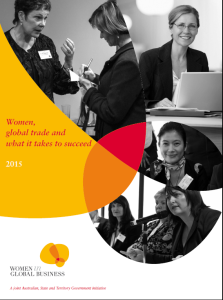Here concludes the trilogy of findings from our latest Women in Global Business report. There are two sets of findings I want to highlight.
China’s rise: The international markets most frequently identified by the Australian businesswomen we surveyed as the  most important market were China (34%), the USA (23%), and the UK (7%). China was more frequently cited as most important (36%) for the more experienced organisations (those operating internationally for over five years). China has jumped considerably since our first survey (from 18% to 34%). This year we also asked about the most important region and Asia was ranked #1 by just over half (52%) the women.
most important market were China (34%), the USA (23%), and the UK (7%). China was more frequently cited as most important (36%) for the more experienced organisations (those operating internationally for over five years). China has jumped considerably since our first survey (from 18% to 34%). This year we also asked about the most important region and Asia was ranked #1 by just over half (52%) the women.
For more on China, see p.32 of the report.
The challenges of global expansion: Australia’s businesswomen have confronted, and overcome, a number of hurdles in their internationalisation efforts. Among the most substantial barriers we identify are: the high $A, difficulty locating a suitable distributor, red tape issues in establishing foreign operations, a lack of resources to cover the investment timeframe (especially relative to the costs), and a lack of alternative sources of capital.
 Women running their own international organisations consistently rated these impediments as higher than the senior female employees (the exception was on the currency risk front). This is symptomatic of the large differences in access to resources, networks and information for these two groups of women.
Women running their own international organisations consistently rated these impediments as higher than the senior female employees (the exception was on the currency risk front). This is symptomatic of the large differences in access to resources, networks and information for these two groups of women.
This second annual survey allows us to track the progression of a subsample of the women from the first survey. Almost two thirds (63%) of the women who had indicated an intention to expand the number of countries in which their business operated had achieved this goal in 2014.
Doing business abroad has not got easier however. As these women expand their businesses into new locations, they continue to encounter issues that hinder growth. On almost all of the 31 issues we track across the survey, the respondents report the barrier to be causing more or similar hindrance to 12 months earlier. The only two to drop noticeably are cultural differences and the perceived risks of losing money selling products or services abroad.
The barrier that has most consistently increased is lack of alternative sources of capital. In this second annual survey we specifically investigate financing challenges which emerged from the inaugural survey as particularly salient for Australian businesswomen in the international arena. We find that most internationalised women‐owned organisations rely primarily on personal savings and reinvested profits to fund expansion. Only 21% of the owner-operators had attempted to borrow to fund internationalisation, and of these attempts, only 27% were successful. Only 10% of respondents regarded ease of accessing finance as easy or very easy, while 55% rated it difficult or very difficult.
Almost two fifths (39%) of the internationally engaged owner-operators felt that gender made a difference to their access to finance. This number was considerably higher (52%) for female owner-operators who were yet to internationalise. This does point to an often underplayed constraint to ongoing international expansion of women-owned Australian organisations.
Our report identifies a number of opportunities to nurture and assist Australia’s businesswomen in their international efforts. We offer promising evidence of the positive impact of mentoring in reducing barriers and building confidence, and a clear appetite for greater access to mentors. Programs such as WIGB are ideal mechanisms for increased sharing of information, contacts and lessons from successful counterparts, the building of skills and capacity, networking, and as a forum for offering specifically targeted policies and interventions.
To read more, see the report.




